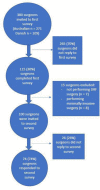Can the results of a randomized controlled trial change the treatment preferences of orthopaedic surgeons?
- PMID: 33215153
- PMCID: PMC7659699
- DOI: 10.1302/2633-1462.19.BJO-2020-0093.R1
Can the results of a randomized controlled trial change the treatment preferences of orthopaedic surgeons?
Abstract
Aims: The aim of this study was to investigate surgeons' reported change of treatment preference in response to the results and conclusion from a randomized contolled trial (RCT) and to study patterns of change between subspecialties and nationalities.
Methods: Two questionnaires were developed through the Delphi process for this cross-sectional survey of surgical preference. The first questionnaire was sent out before the publication of a RCT and the second questionnaire was sent out after publication. The RCT investigated repair or non-repair of the pronator quadratus (PQ) muscle during volar locked plating of distal radial fractures (DRFs). Overall, 380 orthopaedic surgeons were invited to participate in the first questionnaire, of whom 115 replied. One hundred surgeons were invited to participate in the second questionnaire. The primary outcome was the proportion of surgeons for whom a treatment change was warranted, who then reported a change of treatment preference following the RCT. Secondary outcomes included the reasons for repair or non-repair, reasons for and against following the RCT results, and difference of preferred treatment of the PQ muscle between surgeons of different nationalities, qualifications, years of training, and number of procedures performed per year.
Results: Of the 100 surgeons invited for the second questionnaire, 74 replied. For the primary outcome, six of 32 surgeons (19%), who usually repaired the PQ muscle and therefore a change of treatment preference was warranted, reported a change of treatment preference based on the RCT publication. Of the secondary outcomes, restoring anatomy was the most common response for repairing the PQ muscle.
Conclusion: The majority of the orthopaedic surgeons, where a change of treatment preference was warranted based on the results and conclusion of a RCT, did not report willingness to change their treatment preference.Cite this article: Bone Joint Open 2020;1-9:549-555.
Keywords: Decision-making process; Evidence-based medicine; Pronator quadratus muscle.
© 2020 Author(s) et al.
Conflict of interest statement
ICMJE COI statement: The authors have no financial or competing interests to disclose.
Similar articles
-
No effect on functional outcome after repair of pronator quadratus in volar plating of distal radial fractures: a randomized clinical trial.Bone Joint J. 2019 Dec;101-B(12):1498-1505. doi: 10.1302/0301-620X.101B12.BJJ-2019-0493.R1. Bone Joint J. 2019. PMID: 31787001 Clinical Trial.
-
A systematic review and meta-analysis of the pronator quadratus repair following volar plating of distal radius fractures.J Orthop Surg Res. 2020 Sep 16;15(1):419. doi: 10.1186/s13018-020-01942-w. J Orthop Surg Res. 2020. PMID: 32938491 Free PMC article.
-
Examination of the pronator quadratus muscle during hardware removal procedures after volar plating for distal radius fractures.Clin Orthop Surg. 2014 Sep;6(3):267-72. doi: 10.4055/cios.2014.6.3.267. Epub 2014 Aug 5. Clin Orthop Surg. 2014. PMID: 25177450 Free PMC article.
-
Repair of the pronator quadratus after volar plate fixation in distal radius fractures: a systematic review.Strategies Trauma Limb Reconstr. 2017 Nov;12(3):181-188. doi: 10.1007/s11751-017-0288-4. Epub 2017 May 17. Strategies Trauma Limb Reconstr. 2017. PMID: 28512698 Free PMC article. Review.
-
Is pronator quadratus repair necessary to improve outcomes after volar plate fixation of distal radius fractures? A systematic review and meta-analysis.Orthop Traumatol Surg Res. 2020 Dec;106(8):1627-1635. doi: 10.1016/j.otsr.2020.06.003. Epub 2020 Nov 11. Orthop Traumatol Surg Res. 2020. PMID: 33189664 Review.
Cited by
-
Integrated care systems, research, and innovation.Bone Joint Res. 2021 Sep;10(9):591-593. doi: 10.1302/2046-3758.109.BJR-2021-0281.R1. Bone Joint Res. 2021. PMID: 34490784 Free PMC article. No abstract available.
References
-
- Yammine K. Open access of evidence-based publications: the case of the orthopedic and musculoskeletal literature. J Evid Based Med. 2015;8(4):181–184. - PubMed
-
- Zaidi R, Abbassian A, Cro S, et al. . Levels of evidence in foot and ankle surgery literature: progress from 2000 to 2010? J Bone Joint Surg Am. 2012;94(15):e1121– 10. - PubMed
-
- Hanzlik S, Mahabir RC, Baynosa RC, Khiabani KT. Levels of evidence in research published in the Journal of Bone and Joint Surgery (American volume) over the last thirty years. J Bone Joint Surg Am. 2009;91(2):425–428. - PubMed


